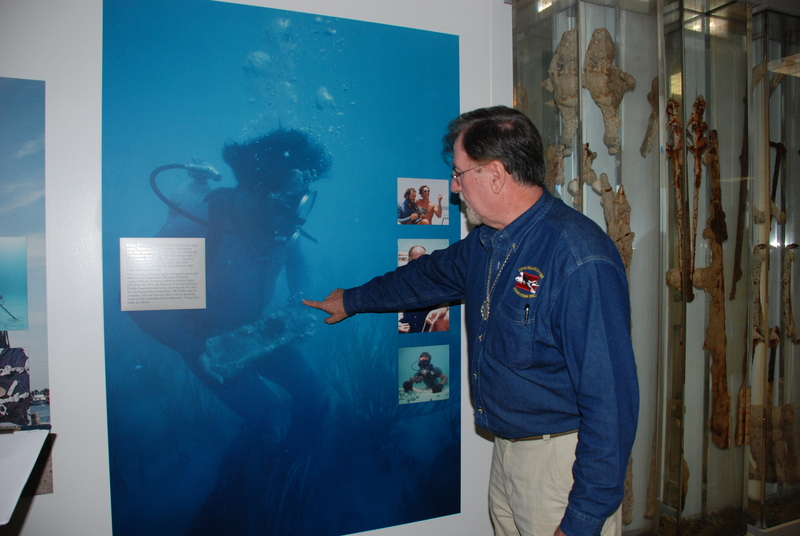Atocha diver on book tour visits Treasures of the Sea Exhibit at Delaware Tech for first time

There are not too many people who can walk through the Treasures of the Sea Exhibit at Delaware Technical & Community College in Georgetown, look at the life-size photos on the wall and say “Hey, that’s me!” But then again, most people wouldn’t describe themselves as treasure hunters either.
As chief videographer for treasure hunter Mel Fisher's expeditions and former vice president of Fisher’s companies, Pat Clyne has been involved with the recovery projects of sister ships Atocha and Margarita for over 35 years. A native of New York, Clyne began studying photography in 1966 while in the U.S. Air Force. After attending the Coastal Diving Academy in New York, he teamed up with world famous treasure hunter Fisher while on a shark hunting expedition to Key West, Fla.
Clyne was involved in the Atocha and the Margarita shipwreck expeditions that resulted in millions of found treasure and documented it all in photographs and video. The ill-fated Spanish galleons Nuestra Senora de Atocha, which sank off the Florida Keys in a hurricane in 1622 and the Santa Margarita were elusive to treasure hunters for over 300 years. His new book, “Atocha Odyssey,” tells the story of Fisher and his family and Fisher’s relentless optimism that led him on a decades-long journey that eventually ended in found treasure and a fight with the U.S. Supreme Court for rights to the bounty, found in coastal waters off the Florida Keys.
The Treasures of the Sea Exhibit, which Clyne visited for the first time recently, showcases the riches recovered from the ill-fated Atocha. Among the treasures recovered are silver and gold ingots and coins, gold chains, jewelry, and bronze cannons. Fisher and his crew spent 16 years looking for the ship before finding the “Motherlode” which consisted of millions of dollars worth of treasure in gold, silver and jewels.
After touring the museum, Clyne said he was surprised at how many cannons were at Delaware Tech. Clyde explained in the book that Fisher’s oldest son Dirk found nine cannons before he and his wife and fellow ship member drowned at sea. Later Clyne remarked that it was “the worst part of the trip.”
A week after their deaths, the rest of the crew found the motherlode.
“It was July 20, 1985,” wrote Clyne, of the day they found the motherlode. Exactly ten years to the day that Kane [another of Fisher’s sons that had been on Dirk’s boat] had been abruptly awakened in the middle of the night and tossed into the sea with the remainder of the Northwind crew. It was ten years ago that his brother Dirk had drowned,” he wrote.
Clyne wrote of the excitement of that day and of the range of emotions - of Kane realizing that the date had such sadness attached to it, all the while knowing what they had finally found. He quoted Kane as calling [Mel] Fisher’s office in Key West and saying, “Put away the charts, Dad; we’ve got the motherlode.”
Walking around the museum, Clyne narrated what they were doing when each artifact was found, repeating many of the stories exhibit coordinator Gayle Chandler tells to the exhibit visitors; only this time the narration comes with firsthand knowledge and the excitement that only someone who was there can have. He was shocked to see a multi-purpose bosun’s whistle that he remembered a fellow diver finding.
“Nobody knew where that was!” he exclaimed, visibly shocked that the artifact ended up in Georgetown, some 1,200-plus miles from Key West. Chandler explained that it came from Melvin Joseph, a local name in Sussex County and an early investor in Mel Fisher’s treasure hunt. The two had met in Daytona Beach, Fla., and shared an interest in treasure hunting.
“I’m so surprised, but if it came from Melvin Joseph, that’s got to be the original,” he said, before reminiscing about the day it was found more than 20 years ago.
“We were out all day long and were about to quit, and the guy I was with, he went down and found it and didn’t know what it was,” Clyne said.
He said after they came to the surface, his friend and fellow diver blew the whistle part; sand and water came out as did the all-too familiar sound. “Some 400 years later and it whistled,” he said. “I got chills when I heard that.”
He also spoke of the adrenaline it took to bring 83-pound silver bars to the surface and to pick up a 200-pound chest of silver coins. “Do you know what it’s like to carry an 83-pound silver bar to the surface?” he asks rhetorically, explaining that the mixture of adrenaline and the fluidity of the ocean made it a doable feat.
Clyne was also impressed with the diorama depiction of the shipwreck, complete with lighting in the background and bodies underneath the wreckage; built into the walls of the museum. It’s a 3D glimpse of how the hurricane affected the ship and its cargo. He said he believes many people on board went to the top deck of the ship, rather than down below, because they have yet to find any human bones.
Although cattle bones and other animal bones have been found, he said the only logical explanation to the lack of human bones would be that people raced to the top of the ship, and their bones were lost at sea. Because there were two hurricanes, one about a month after the first, he said the logical explanation of finding the top half of the ship with the cannons nine miles away is that the force of the second hurricane “ripped the superstructure,” from the bottom half and moved it.
Chandler wrote down all these new tidbits of information, especially about Clyne’s interpretation of the lack of human bones. She said later that it was an honor to have Clyne view the museum.
“Very few people [involved in the recovery expedition] have ever visited,” said Chandler. “Mr. Clyne just called out of the blue and asked if I knew who he was, and I said ‘Of course!’ I had seen his name ever since 1988 when I first started working here. He was the photographer so he was an integral part of the Mel Fisher salvage operation.”
“It was nice to have him check us out,” she said. “It sort of validated our existence.”
Clyne was pleased with his visit as well. “It was a walk down memory lane,” said the diver, who still works on underwater documentaries and is presently filming a Delaware project about a DuPont mansion that is currently at the bottom of Hoopes Reservoir near Greenville and hasn't been seen since the dam was built in 1933.
“I am truly amazed with my own nostalgia. The cannons, the jewelry - I have not seen some of these things in decades,” he continued. “The search for the Atocha could not have been possible without the entrepreneurship and optimism of such visionaries as Melvin Joseph and Mel Fisher - two people who saw a dream, pursued it, and accomplished their goals against the odds and all the government roadblocks they encountered. A real tribute to American ingenuity and the stuff legends are made of.”
To purchase the book, visit the Treasures of the Sea Exhibit at Delaware Tech in Georgetown or find it on amazon.com. For more information on the museum or to schedule a tour, visit treasuresofhesea.org or call 302-856-5700. The exhibit is offering free admission to anyone purchasing the book.

















































